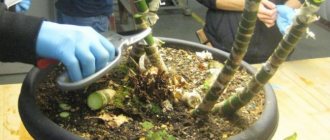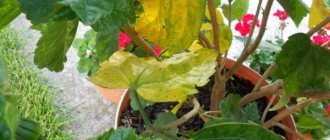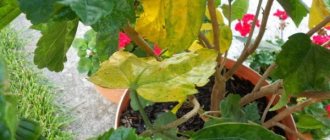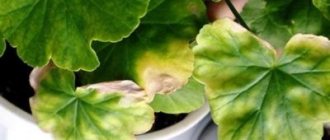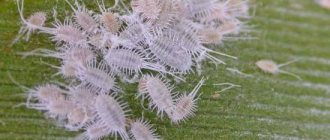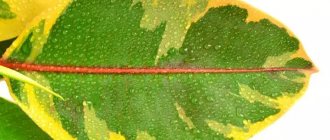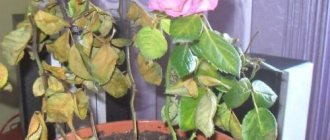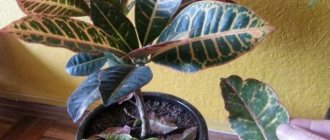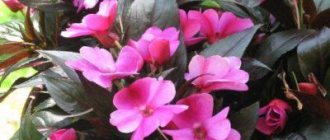Hibiscus is a capricious plant; it must be cared for strictly according to certain rules. Indeed, with the slightest change in favorable conditions, the Chinese rose responds with the loss of its decorative qualities. Then suddenly the leaves begin to turn yellow, and then real leaf fall occurs. There is definitely an explanation for this behavior of an indoor flower. It is possible that this is due to disease or pests, or maybe the hibiscus is under stress. It is important for the gardener to quickly establish why the hibiscus leaves turn yellow, the cause of the negative changes, and take urgent measures to save the plant.
The main causes of yellow leaves and their elimination
It is impossible to say with certainty the reason for the loss of an attractive plant appearance without analyzing many factors. A thorough examination and analysis of all parts of the plant, soil, location of the bush, and recent conditions will help to find out why the leaves turn yellow. We will look at the most common reasons.
Watering
Hibiscus is a tropical plant that requires a lot of moisture only in the hot season. During the cold season, water stagnates if you water too often. Because of this, the root system begins to rot, growth stops, and leaves fly off due to lack of nutrients.
Insufficient watering
In high temperatures, hibiscus require a lot of water, sometimes even twice daily watering if the weather is really hot or windy. Drip irrigation systems can be a great way to keep your plant from going dry.
Abundant watering
Hibiscus can suffer from excess water, especially during dark and cool seasons. They like moist soil, but cannot tolerate "swamp", or cold, wet, heavy soil. Therefore, excessive watering also causes stress in the root system, which affects the plant as a whole.
Air temperature
Hibiscus is a tropical plant, so it prefers high temperatures. Optimal conditions +20, +25°С. In the summer, with the onset of heat above +30° C, the bush will shed some of its leaves to avoid strong evaporation of moisture. In winter, the plant will withstand +16, +18° C, but if the pot is placed on a window, the cold glass will cause yellowing of the leaves closest to it. Hibiscus will not die even at +12, +14° C, but will shed its leaves in the fall in order to survive in a cool room and save vital energy.
If they are too cold or standing close to cold glass, the reaction will be yellowing of the leaves.
Exposure to sunlight
Hibiscus is undemanding to lighting conditions. But direct sunlight will cause burns on the leaves, which will turn yellow and fall off. The flower will also respond to a lack of light and being in the shade by shedding its foliage - this will help it save energy for further development. In spring, the flower can be moved to a lighted windowsill, closer to the light. In winter, provide sufficient artificial light.
The optimal solution would be to place young plants on western or eastern windows. Diffused light will ensure the normal condition of the leaves, but there will be no flowering if there is not enough sun. An adult bush is placed near southern windows to stimulate the appearance of flowers. In summer, hibiscus feels good on the balcony and in the garden, if it is not exposed to the sun.
Abundant sunshine
Hibiscus love sunlight, but like most people, they prefer a moderate amount. Too much sun stresses hibiscus plants and they react by yellowing the leaves or developing large white spots (sunburn) on the leaves. Too much sun will not kill the plant, but it will cause yellowing and loss of leaves.
A small amount of light
Light is the source of life for plants like hibiscus. If they don't get enough light to support their large shiny leaves, they will drop them, as the fewer leaves there are, the less light the plant needs to survive. However, this means that the amount of chlorophyll needed to support the entire plant is reduced, so the shedding process will continue until only a few leaves remain.
Draft
Hibiscus does not tolerate drafts. Constant movement of air, especially cold air, from an open window in winter, will destroy the plant. When ventilating the room, the pot is removed from the windowsill, since gusts of wind dry the surface of the leaves in the heat, and in winter they are strongly cooled with icy air.
Dry air is a common cause of leaves turning yellow and falling. In the tropics, in the plant’s homeland, high atmospheric humidity is the norm. Therefore, at home it is important to maintain a microclimate that is comfortable for indoor hibiscus.
Dry air is eliminated by placing trays with wet expanded clay near heating radiators and hanging wet towels on radiators. Regular warm showers in the summer will replenish moisture loss and will be a good prevention of parasites. Daily spraying of the leaves of the plant is an essential part of caring for the shrub.
Potty doesn't fit
In order for the plant to actively grow and delight with lush and bright flowering, you need to take care of a comfortable and spacious pot. If the hibiscus is crowded in a flowerpot, then its leaves begin to turn yellow, wither and fall off. The same thing happens with the branches - they wither.
To prevent yellowing of the leaves, it is necessary to plant the plant in a large pot in which its root system will feel free. It is important to remember that hibiscus does not like frequent transplants, in order to injure the plant less, it must be transferred to a new, larger container along with a lump of earth.
Diseases and pests
Buying new flowers in a store, or placing plants on a balcony or in a garden in the summer often leads to the appearance of pests and infectious diseases.
Insects, spider mites
Spider mites are small mites that look like crabs under a magnifying glass. They are usually not visible to the naked eye, but they leave marks on the leaves of hibiscus trees. First, spots appear on the leaves, which look dirty and withered. On the reverse side of the leaf there are traces of mites sucking out the juice. And finally, a thin web becomes visible between the leaves and at the top of the stem. The leaves will turn yellow and fall off, and the entire plant will look unhealthy.
If no action is taken, spider mites can damage all the leaves and the plant will be completely “bald”.
The plant will take weeks to recover, so it is better to take action before such dire consequences occur. Use the drug "Actellik" to combat spider mites on indoor plants; spraying with soapy water (laundry soap) 2-3 times a day also gives good results.
Shchitovka
The harmful effect of the parasite is aimed at the leaves of the plant. Insects feed on the pulp and juice of the leaves, thereby causing them to turn yellow and subsequently fall off. Measures to combat scale insects: treating the flower with Actellik.
Aphid
A common type of pest of indoor plants. Aphids, laying their larvae in the leaves of a plant, cause significant harm to it. The voracious larvae feed on the juice and pulp of the leaves, all of which provokes yellowing and falling off of the affected flower structures. A distinctive sign of aphid pests is the curling of the affected leaves. Measures to combat aphids: spraying the plant with Fitoverm.
Other pests:
- Gall midge - Midge larvae eat away the contents of buds and unopened leaves. It is recommended to collect and destroy damaged buds and leaves, and disinfect the soil.
- Greenhouse whitefly - Damages leaves and causes yellowing. Treatment is carried out with a solution of potassium soap. Preparations - Karbofos, Aktara, Zubr.
- Scale insects - They settle in the axils of leaves, sucking out the juices. Treatment with mineral oil and alcohol solution is recommended. Preparations Confidor, Aktara.
Excess or lack of fertilizers
With frequent fertilization of the soil, the plant’s body experiences stress, something like an excess of sugar in a person’s blood, and reacts to this with yellowing leaves. We can help hibiscus cope with this. When fertilizing the soil of indoor flowers, you need to know exactly the dosage and type of substances they feed on.
- In winter, organic preparations are added - Humisol, Vermisol (2% solution).
- Non-infectious chlorosis - lack of nutrition is treated by watering and spraying with Ferovit solution (1.5 ml per 2 liters of water).
Important! Fertilize an indoor flower during the period of active growth, respectively, in the spring and summer. In winter, the plant must rest, so fertilizing the soil is stopped. The ideal fertilizer option for Chinese roses are formulations marked “For non-flowering indoor plants.”
Incorrect acidity - chlorosis
There are several conditions called chlorosis - the yellow color of the leaves in case of this lesion can vary greatly. The castings will remain partially green and yellow in the part where chlorosis develops. Then the leaves turn completely yellow and fall off. You can save an indoor flower by replanting it in a new soil mixture and adding fertilizers containing iron.
If they do not turn yellow completely and remain on the plant, this indicates a lack of certain nutrients. This can happen due to a lack of fertilizer, or due to the incorrect acidity of the soil becoming too acidic or too alkaline. In this case, the leaves do not turn bright yellow and do not fall off. This problem can be corrected by applying fertilizer and/or adjusting the acidity of the soil.
At home, the soil often becomes alkalized due to too hard water.
Use of pesticides
This is not the most common problem, but using the wrong dosage or the wrong pesticide is the same as spraying a pesticide in hot, sunny weather at midday. May also cause leaf problems. If you use pesticides frequently, this can cause yellowing of the leaves.
- Fertilizers with elements of potassium and magnesium are most suitable for the development of hibiscus; they can be applied without fear.
- Phosphorus fertilizers diluted in water increase flowering, while high phosphorus fertilizers can destroy the flower.
- Nitrogen fertilizers must be applied without exceeding the norm. This is a rather dangerous substance that can cause nitrogen burns.
Insufficient phosphorus
Phosphorus is another very important element for hibiscus. They cannot tolerate too much phosphorus and are slowly damaged by too much phosphorus. One of the most common mistakes made by beginners in growing flowers is the use of high-phosphate fertilizers. These fertilizers contain a very high percentage of phosphorus, which is very harmful to hibiscus.
A gradual increase in the amount of phosphorus with each watering increases flowering. And at the same time, hibiscus droops and turns yellow within a few weeks after applying fertilizers with increased phosphorus.
Average amount of nitrogen
All living plant cells use nitrogen. Too much nitrogen can cause leaf “burn” (“fertilizer burn”), causing leaf tips to darken. But too little phosphorus can stunt the flower's growth. Enough nitrogen must be provided for growth, without too much causing burns.
If you see brown edges on the leaves, stop fertilizing for a couple of weeks and water the plant with plain water. When you start fertilizing again, use regular flower fertilizer, or reduce the amount of fertilizer you apply by half.
Why does this happen to a houseplant?
Partial yellowing of leaves with spots is caused by various reasons. Let's take a closer look at them.
Incorrectly selected pot
It’s easy to check whether the pot is correct. Water the flower in the morning, and in the evening check the condition of the earthen lump in the middle of the pot. If the soil is dry, the container is small for it, we urgently replant it . Otherwise, its leaves will begin to turn yellow, as the flower will try to reduce moisture evaporation by shedding excess leaves.
The new pot should be 1-2 cm larger in diameter than the previous one. Transplantation is carried out by transshipment so as not to injure the roots. The pot must have good drainage. Transplantation is carried out in moist soil, watering begins on the third day.
If water constantly accumulates in the pan, the roots will begin to rot, the leaves will turn yellow and fall off . This indicates that the capacity is large. As in the previous case, a transplant is needed. We remove the plant, along with the earthen lump, from the pot and check for rot. If rot appears, remove it and dust the cut areas with crushed charcoal. We replant into a smaller pot and regulate watering.
Care errors
- Chinese rose is a tropical plant and does not like drafts . It should not be placed within reach of fans or air conditioners. When ventilating the room, it is recommended to cover it with a screen.
- Incorrect lighting . This factor leads to the following consequences:
- When there is insufficient lighting, the rose sheds its leaves, guided by the principle: fewer leaves, less light needed.
- With a lack of sunlight, the leaves turn yellow on the shaded side.
- The bright sun is also harmful - the leaves can get sunburned.
The best option is diffused sunlight. If there is a lack of natural light, fluorescent lamps will help.
- Yellowing of the upper leaves of flowers indicates a lack of nutrients . This can be corrected by increasing the dosage of fertilizers or the frequency of fertilizing. But this must be done carefully so as not to overfeed. Too much fertilizer also causes problems.
- Low ambient temperature . Since hibiscus comes from the tropics, it is thermophilic. The temperature in the room where the rose is kept should be between 18-300 C. Otherwise, the plant begins to shed its leaves. During the rest period, the temperature should not be lower than 15 degrees.
Diseases and pests
Chlorosis
When a Chinese rose is infected with viruses, the leaves not only turn yellow, but also become covered with spots.
One of the common viruses is chlorosis. In a plant infected with chlorosis, the leaves turn yellow, but the veins retain their natural color. Chlorosis indicates improper soil acidity . Sometimes the leaves of an infected plant turn yellow only where the source of the disease appears. And sometimes the leaves turn yellow and fall off, the tops of the plants and underdeveloped roots die off.
It can be corrected with a complex mineral fertilizer such as “Uniflor-Micro”, as well as by transplanting to another soil. Spraying with iron chelate will also help. To avoid chlorosis, it is not recommended to water the flower with hard tap water, because it oxidizes the soil.
Spider mite
Another reason for yellowing leaves is spider mites . It can only be detected if you examine the leaves with a magnifying glass. Without a magnifying glass, you can notice a weightless web on the leaves and buds.
Insecticides, which are sold in flower shops, or washing the leaves with soapy water will help save a sick plant. After ablution, the flower is sent into the shower. The soil in the pot is covered with film.
Even with the help of insecticides, the plant takes a very long time to recover . To prevent the spread of ticks, you need to treat them preventively twice a year. Treatment is carried out with Agravertiv, Fufan or Actllic. Treat three times at intervals of four days.
Spider mites grow where there is dry air. Therefore, in rooms where the air is dry, you need to use humidifiers or place a container of water near the flowers. Regular spraying has a beneficial effect on hibiscus.
Natural causes
Some indoor plant lovers begin to panic even if one or two leaves have fallen from the hibiscus, or they have turned a little yellow. This happens when the hibiscus is actively developing, it has many new leaves, and the old ones die off. There is nothing terrible in this process; natural changes occur in living nature.
Stress
Hibiscus reacts painfully to a change of residence. Even turning it the other way towards the window on the windowsill causes negative consequences. Severe stress for a flower is moving to a new room; adaptation often begins with yellowing and shedding of leaves. Transplanting into another pot is also not an easy test. The plant gets sick and flies around when the root system is disturbed during transshipment and its integrity is damaged. It will take time to restore and grow new roots, so the hibiscus sheds its foliage and does not waste energy on it.
Infections from other plants
Viral and fungal diseases are difficult to treat; too quickly the infection ends in the death of the plant. Prevent the occurrence of infections by increasing the immunity of the bush. It is replanted in time, fed, and the leaves are cleaned of dust.
Hibiscus treatment:
- The flower is removed from other plants and contact with them is limited.
- Collect and destroy all damaged parts.
- Cut off yellowed leaves, buds, and dry shoots.
- Spray the bush with an antifungal drug. Domotsvet, Dezavid, Tsitovit are used.
- Among folk remedies, treatment with Trichopolum is used (2 tablets per 1 liter of water).
Aftercare
The Chinese rose will freely grow new foliage after treatment and freedom from pests. To do this, you need to remove all dried branches and leaves. Every spring, a young plant needs to be replanted; it is done using the transshipment method, and each time the flower is transplanted into a more spacious pot, leaving room for roots to grow.
Hibiscus is transplanted into light and nutritious soil. It is desirable that it consist of leaf soil - 1 part, turf soil - 2 parts and humus soil - 1 part. In addition, coarse sand is added to the soil, and bone meal can be added. Drainage is placed at the bottom of the pot, which can consist of broken bricks, ceramic shards, crushed stone, gravel or expanded clay. The main condition is that drainage should not injure the roots.
To form a beautifully shaped bush, you will need to trim shoots that are too long. Old, dried out, damaged or weak shoots are removed. Sometimes the tips of the shoots of a young plant are pinched to form a crown. The cut areas are powdered with charcoal. After pruning, the temperature in the room is reduced by 2°C. The soil should not be allowed to dry out, so the plant should be sprayed with water at room temperature every day.
An adult flower that is more than 3-4 years old is replanted every 3-4 years. Every spring, add a small layer of new soil to the pot on top of the old soil.
Why leaves turn yellow and hibiscus drops buds
The buds of a Chinese rose turn yellow and fall off for several reasons:
- If during budding the pot with hibiscus is moved from place to place. The pot should be in one place.
- If the plant is in a poorly lit place. Move it closer to the light.
- If you water a flower with cold water. Water for irrigation should be used at room temperature and settled. You can use melt water after defrosting the freezer.
- When the soil in the pot dries out. It is necessary to water regularly, in the morning or evening, every two days.
- When the substrate is very waterlogged.
- If there is a shortage of fertilizer. During the growing season and flowering, hibiscus requires more nutrients than during the dormant period. It must be fed with complex fertilizer, which contains a minimum amount of phosphorus. From excess phosphorus, the leaves turn yellow. Fertilizing should be applied in cloudy weather, in well-moistened soil.
- If the plant has unsuitable soil. The soil should consist of two parts of turf and one part each of humus, leaf soil and sand.
After finding out the cause of yellowing of the leaves of a Chinese rose, and after eliminating it, the flower will quickly recover. At this time, you can prune long shoots. You can also learn more about why hibiscus buds and leaves fall off here, and here we also talked about the reasons why the plant does not bloom.
Malnutrition
Overuse of fertilizers is a common cause of Chinese rose wilting. This plant does not tolerate the thoughtless use of pesticide fertilizers. The result of excessive use of them is yellowing of the leaves. To eliminate the risk of flower death, it is necessary to use one form of these fertilizers in minimal quantities. Fertilizing with pesticides should be done either in the early morning or in the evening before sunset.
Similarly, hibiscus does not tolerate an excess of phosphate fertilizers. Externally, excessive use of these fertilizers leads to yellowing of the leaves; internally, it “blocks” the flower’s nutritional system, preventing it from consuming other nutrients.
Particular care should be taken when fertilizing the crop with nitrogen fertilizers. Improper application of the additive can lead to leaf burns and gradual death of the entire plant.
Observation of characteristic brown spots indicates oversaturation of the soil with nitrogen and the need for therapeutic therapy. It is necessary to stop any feeding and water the rose only with clean water for 2 weeks. As the plant emerges from the crisis, this element must be gradually introduced in small quantities until the optimal dose for a particular plant is selected.
To feed hibiscus at home, using a sugar solution is effective. To prepare it, you need to mix 0.5 tsp. granulated sugar and a glass of water. The resulting product is used to water the soil according to its moisture content. To treat a plant from sunburn, it is recommended to wipe the affected leaf with this solution.
The Chinese rose is one of the non-capricious plants that do not require special care. An essential factor in maintaining it in a healthy state is compliance with the rules of maintenance, sanitation, and feeding. By following these simple principles, you can easily prevent the problem of flower wilting.
It is not a difficult plant to care for. They usually require minimal care and acceptable growing conditions. But unpleasant moments also happen. In particular, hibiscus leaves turn yellow and fall off. Most often this happens with indoor hibiscus. There are many reasons for this annoying phenomenon. Therefore, in order to eliminate the problem, it is necessary to establish the cause as quickly as possible and begin to eliminate it.
What to do to prevent leaves from turning yellow
The main reasons why hibiscus leaves fall and turn yellow are described above. But unpleasant situations can be avoided if you adhere to the following preventive basics:
- Regulate watering of the flower.
- Do not allow the plant to be in a draft.
- Provide regular feeding to hibiscus.
- Limit plants from direct sunlight.
- Plants affected by the virus should be immediately destroyed before the disease spreads to other flowers.
- Control pests in a timely manner using effective and safe products.
Hibiscus is unpretentious, will not die after the foliage is completely shed and will grow new shoots instead of cut ones. But proper care and compliance with maintenance conditions will allow the plant to look attractive even without flowers and always delight with healthy glossy foliage.
Photo
In the photo below you can see yellow spots on the hibiscus foliage, as well as other signs of yellowing.
Hibiscus lovers may find the following articles useful:
- leaf diseases;
- drying of roots, stems and leaf tips;
- leaf curling;
- dropping buds.
Rest period
In order for hibiscus to grow beautifully, bloom magnificently and not get sick, it needs to be properly cared for during the dormant period.
First he needs to do some pruning . This must be done not only to form a bush, but also to remove weak, poorly formed shoots. They won't have flowers anyway.
Reference! During the dormant period, the flower prepares for beautiful lush flowering. Accordingly, the conditions of detention should be optimal: the air temperature should not be lower than 150 C.
Video
Sources
- https://rusfermer.net/dom-kvartira/tsvety-kv/tsvetushhie/gibiskus/bolezni-i-vrediteli/zhelteyut-i-opadayut-listya.html
- https://GreenParkOmsk.ru/domashnie/kitajskaya-roza-opadayut-listya.html
- https://alt-zem.org/tsvety/chto-delat-esli-u-gibiskusa-zhelteyut-i-opadayut-list-ya.html
- https://kartoska.ru/pocemu-u-gibiskusa-zelteut-lista/
- https://flowertimes.ru/pochemu-u-gibiskusa-zhelteyut-i-opadayut-listya/
- https://podokonnik.temadnya.com/1785451703312582901/chto-delat-kogda-zhelteyut-i-opadayut-listya-u-gibiskusa/
- https://SadDrakona.ru/dom/kitajskaya-roza-zhelteyut-listya.html
- https://sadovnic.su/yagody/gibiskus-sbrasyvaet-listya.html
- https://floriums.ru/pochemu-zhelteyut-listya-u-gibiskusa-i-chto-delat
- https://vashcvetok.ru/bolezni-i-vrediteli/zhelteyut-i-opadayut-listya-u-gibiskusa
- https://felisov.ru/komnatnye-rasteniya/kitajskaya-roza-zhelteyut-listya-i-opadayut.html
- https://naogorode.net/pochemu-zhelteyut-listya-u-gibiskusa-komnatnogo/
Pests that cause leaf death
Hibiscus is distinguished by excellent health and high resistance to diseases. A common cause of disturbances in its development are pests obtained during contact of the rose with other representatives of the fauna. A common source of its wilting is infection:
- whiteflies;
- spider mite;
- aphids;
- gall midge, etc.
Symptoms of whitefly infestation are yellowing and the appearance of a sticky coating on the leaves. The advanced stage is characterized by the development of pale yellow larvae at the base of the leaf. To eliminate the pathology, it is recommended to treat the affected areas with a solution of potassium soap.
The appearance of cobwebs, accompanied by large yellow dots and dry leaves, indicates a spider mite infestation. For treatment, it is recommended to treat the lesions with a soap solution or mineral oil. A special feature of the product is that it envelops the leaf with a thin film, which does not interfere with gas exchange, but protects it from the action of the mite.
The dryness and stickiness of young buds indicates damage to hibiscus by aphids. For the prevention and treatment of the plant, it is recommended to periodically treat it with a soap solution.
The result of flower damage by scale insects and false scale insects is the appearance of characteristic tubercles of various shades: from gray to brown. In the initial stage of the disease, they are carefully removed with tweezers, after which the infected areas are treated with mineral oil. For the treatment of large lesions, the use of an insecticide is recommended.
A characteristic feature of gray rot is thinning of the stems and falling leaves. To prevent the disease, when planting hibiscus, it is necessary to treat the sprouts with Rovral and try to place them away from each other.
The result of the activity of the gall midge is yellowing and premature falling of unopened buds. To prevent further spread of the pest, you must immediately remove the deformed bud and fertilize the soil with a substance against soil pests.
Incorrect lighting level
Hibiscus is a fairly shade-tolerant plant, but if there is too little light, then it will certainly react to such neglect of its needs with massive yellowing and falling leaves. As a rule, gardeners often encounter a similar problem when moving their pet from the street (from the garden or from the balcony) into the house. A sharp change from the usual bright sun to a dimly lit room causes stress in the plant. To help him acclimatize faster and survive the move without loss, it is necessary to use additional illumination with phytolamps.
The opposite problem is sunburn of leaves, due to which delicate leaf blades become covered with yellow, white, and sometimes shapeless spots burnt to black. To avoid such troubles, hibiscus taken out into the fresh air should be gradually accustomed to the sun, providing it with shading during the midday hours. The same measures should be taken for plants placed on the south window.
Advice from flower growers
To avoid the appearance of yellow leaves on a Chinese rose, you need to use a few tips:
- Watering should be moderate;
- Treat foliage with special means;
- Don't forget about feeding;
- Limit the abundance of sunlight.
By detecting the problem in time, understanding its cause and taking the necessary measures, you can save your favorite plant. Coordinated actions and good advice will allow you to enjoy the wondrous beauty of the Chinese rose for a long time.
How to save a flower
Imagine the situation: you brought a fresh new hibiscus from the store that you just bought, but after a few days you noticed that it was dropping leaves that had turned yellow. This is primarily due to the stress of transportation. To save the plant, we treat it with Epin once a week, repeating the procedure 2-3 times.
If the leaves continue to fall within three weeks, then you need to urgently check the roots. They need to be washed, dried and spoiled trimmed, and the plant transplanted into a new pot. Considering the variety of reasons why a plant turns yellow, diseases cannot be ruled out. To prevent infection, hibiscus should be inspected, frequently sprayed and ventilated. Fitover helps in the fight against insects. Drugs with a special composition are used against fungi.
Humidity level
This flower usually requires good drainage soil and a stable supply of organic matter. It is necessary to care for it at home competently, but without much difficulty. It is enough to maintain a certain moisture content in the soil, avoiding root rot in too wet soil.
- It is desirable that the substrate contains clay, which in a high flowerbed will help the plant develop faster and grow as efficiently as possible.
- It is advisable to mulch the soil to prevent diaper rash.
- Frequent watering should not lead to stagnation of water in the pot.
- The drip irrigation method will be effective. When watering, it is better to avoid getting water on the petals - they are too delicate and may deteriorate.
- The flower needs to be sprayed regularly enough to create a humid atmosphere.
In it, the Chinese rose “breathes” better and receives additional moisture. This factor is of great importance at home, when batteries and heaters are actively working near the rose.
Disease Prevention
It is much easier to prevent some diseases by taking certain measures than to treat them later, for fear of losing the entire plant.
Burn
Thus, sunburn is prevented by gradually accustoming greenhouse and indoor flowers to sunlight. They start with a short time, then increase it. The rose is transferred to a permanent sunny place after complete adaptation. If the burn could not be prevented, do not panic - having dropped the damaged foliage, the hibiscus will soon grow new ones.
Leaf burns
Chlorosis
This unpleasant disease is quite easy to prevent. The non-infectious form arises from a lack of iron, therefore, when watering the plant only with settled water, add a couple of drops of iron chelate to it. Fertilizers must contain sufficient amounts of nitrogen.
It is better to prevent the infectious form immediately:
- Avoid contact with infected plants;
- When washing hibiscus, cover the soil of the flowerpot with film;
- The plant needs regular replanting and a sufficient amount of fertilizer;
- All new plants must be quarantined.
Urgent measures
If the leaves of an indoor hibiscus turn yellow, then you need to urgently start treating it. This is easy to do if you immediately identify the cause of the plant disease.
If the cause of yellowed leaves is insufficient lighting, then you should take care of a sunny windowsill. In a poorly lit area, hibiscus will bloom poorly or not bloom at all. If it is hot and the air temperature is more than 25 degrees, then during the daytime the plant must be moved to a dark place or simply lowered from the windowsill to the floor. If the sun does not appear for a long time, then you need to take care of additional lighting for the flower. Fluorescent lamps are used for this purpose.
Pests
Spider mites are a real scourge of hibiscus. At the first stages of its invasion, this pest is practically invisible and does not betray its presence in any way, but the plant’s leaves soon begin to turn yellow and fly off en masse. Later on young shoots you can notice cobwebs, on the threads of which tiny moving dots become noticeable.
The fight against spider mites should begin as early as possible. As soon as it is detected, the crown of the bush must be treated with a targeted chemical. In particular, products such as Actellik, Aktara, Neoron, and Fitoverm have proven themselves to be effective against ticks.
Hibiscus diseases, their treatment
White coating on leaves
White bloom on hibiscus foliage is the main symptom of such an unpleasant disease as powdery mildew. It spreads very quickly, after a short time almost every leaf of a Chinese rose appears in white spots. The spots gradually increase in size, become brown and acquire a filmy structure. The leaves begin to curl, wither and fall off. If no measures are taken, the indoor flower will die very quickly.
Important! Powdery mildew spreads especially quickly if the crop is planted in nitrogen-rich soil. If the disease was detected at the initial stage, the flower can be saved
The first step is to remove all leaves affected by powdery mildew. The plant must be treated with an antibiotic solution. If they are not available, you can use some home remedies
If the disease was detected at the initial stage, the flower can be saved. The first step is to remove all leaves affected by powdery mildew. The plant must be treated with an antibiotic solution. If they are not available, you can use some home remedies.
The most commonly used solution is baking soda (two tablespoons per liter of water). The entire plant should be thoroughly sprayed with the composition.
Another common option is a soap solution with the addition of copper sulfate. Having dealt with plaque on the leaves, you should provide the hibiscus with the most comfortable conditions for growth in order to avoid a recurrence of the problem.
Dropping unopened buds
Some gardeners complain that hibiscus begins to drop unopened buds. Most often, the reason why the plant does not want to bloom, and its unopened bud falls off, is due to the fact that the care of the Chinese rose is not organized correctly.
If your hibiscus drops its buds, there is cause for concern.
The following factors may cause the problem:
- too low or high temperature - so that the plant does not begin to shed buds and can bloom normally, it must grow at +23 degrees in summer and +18 degrees in winter;
- direct exposure to sunlight - they burn the plant, and the still unopened bud begins to dry out;
- too frequent watering, causing rotting of the root system;
- poor drainage;
- lack of feeding - lack of nutrients in the soil is stressful for the Chinese rose;
- frequent movements of the plant - hibiscus response to stress - falling buds.
Hibiscus chlorosis
Many novice gardeners wonder when hibiscus leaves turn yellow and fall off, what to do. If no pest is identified, and there is no cobwebs or plaque on the foliage, most likely we are talking about a fairly common disease. The answer to the question of why hibiscus leaves turn yellow lies in a diagnosis such as chlorosis.
Hibiscus chlorosis is a fairly common disease.
This disease is associated with a violation of the formation of chlorophyll in the foliage. The yellowed leaf has green veins.
The reasons why chlorosis may develop and leaves turn yellow are as follows:
- lack of elements such as magnesium, zinc, sulfur, lime and iron in the soil;
- infection or microorganisms caused by insects;
- germination defects;
- poor soil condition;
- lack of drainage;
- hereditary factor.
Not only yellowing of the leaf blade is a symptom of chlorosis. In addition, the leaves begin to decrease in size, their edges begin to curl, the shape of the buds and flowers changes, and the apical shoots dry out.
Treatment of chlorosis is possible only with the use of special preparations: Agricola, Fkerovit, Antichlorosin, Iron Chelate, etc. The compositions are applied at the root or used for spraying.
To prevent yellowing of foliage from starting, some preventive measures will be effective.
In particular, it is important to choose a good substrate for the flower - light and permeable, pay attention to the acidity of the soil and prevent it from becoming alkalized, and also periodically water the plant with water acidified with citric acid. A few grains are enough per liter of water.
In most cases, if you organize proper care, questions about why the leaves of a Chinese rose turn yellow and fall off and what to do in this case will most likely not arise.
Rules for successful pruning
- First you need to decide for what purpose the pruning is carried out and in what way it will be carried out. The formation of flowers in Chinese roses occurs at the tops of the stems. When the branches are pruned, the tree begins to bush more and produces more flowers. The plant is pruned in early spring; hibiscus can be trimmed a little in the fall.
- Pruning tools must be clean and very sharp. Poorly sharpened scissors and knives make the cut torn, worsen the appearance of the plant, and cut branches will take a long time to heal. Before each pruning procedure, tools are not only washed, but also disinfected. It is best to use alcohol for disinfection.
- It is best to prune hibiscus after transplantation, in spring or summer. After the procedures, caring for the rose remains the same.
- Even before you start pruning, you need to decide what shape you need. All cuts must be made at an angle of 45 degrees. Caring for a rose immediately after pruning, in order to avoid infection of the Chinese rose and for faster healing of wounds, includes sprinkling all cuts with crushed charcoal. You can use charcoal or activated carbon.
- The top of the plant is trimmed, moving away from the place where the last upper branches grow. The shoots are shortened a second time when the plant finishes flowering.
- The main rule for pruning a Chinese rose is that you can trim no more than 2/3 of all branches.
Thanks to these rules, the plant will receive minimal injuries, which will heal quickly.
How to prune hibiscus
The most popular form of hibiscus, which has a very impressive appearance, is the standard. Forming it at home is not so easy, and after the plant takes on the desired shape, regular care is required for the branches to maintain the standard shape of the crown. But if you follow the instructions, you can get an amazing standard Chinese rose tree.
- To obtain a standard form, choose a young hibiscus. Its central shoot must be straight. Then this shoot is tied to a reliable support at the same distance and is not removed until the trunk becomes strong and stable. Growing side shoots are periodically removed.
- When the plant reaches the required height, the top of the plant is pinched. This is done to stimulate the growth of side shoots.
- After removing the top, the hibiscus will begin to actively branch. Therefore, the side branches are shortened and pinched monthly. This measure will promote the growth of dormant buds and the growth of new shoots.
All lower shoots continue to be removed, but the upper ones are not touched. Over time, the plant will acquire the desired spherical shape. To maintain a neat decorative shape at home, careful care is required. Hibiscus is periodically trimmed, preventing the crown from growing. The haircut is done once a year in the autumn months. If you do this at another time, the hibiscus will not bloom.
Chinese rose in bonsai form
You can try growing a bonsai-style tree from hibiscus. But the formation of a Chinese rose for such a plant is very difficult and time-consuming. Professional florists can produce beautiful trees decorated with many flowers. Such plants will look very impressive and unusual in the interior. The main problem when forming a bonsai is that the hibiscus branches quickly become thick and woody.
To form a bonsai, you need to take a young plant. Its branches are tied to supports and tension devices
You need to guide their growth very carefully; this can be done using wire. When the branches reach a length of 10–20 cm, they need to be cut off and leave no more than three leaves.
When a young plant begins to form, this may affect flowering, but for the sake of a beautiful, well-groomed form, it is worth waiting for the flowers to appear.
You should not be afraid to radically trim and thin out your hibiscus; on the contrary, by getting rid of old and unnecessary branches, the plant receives more nutrition for the formation of flowers and the growth of new strong shoots. Proper formation of the plant's crown will make the hibiscus the main decoration of your home or greenhouse.
www.pro100-cvety.ru
